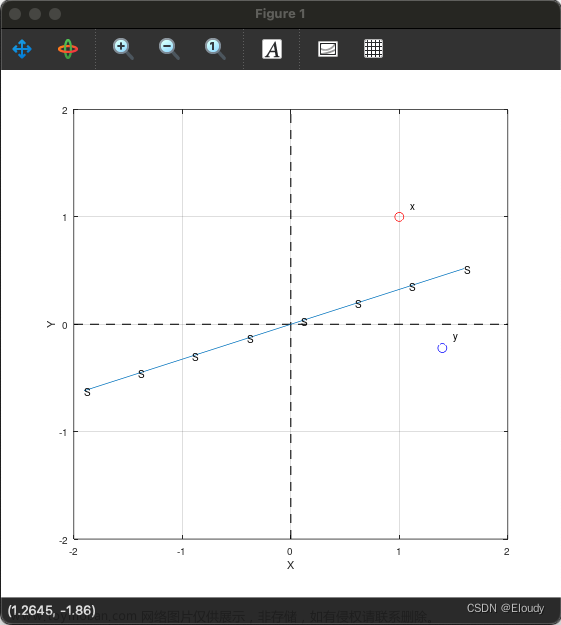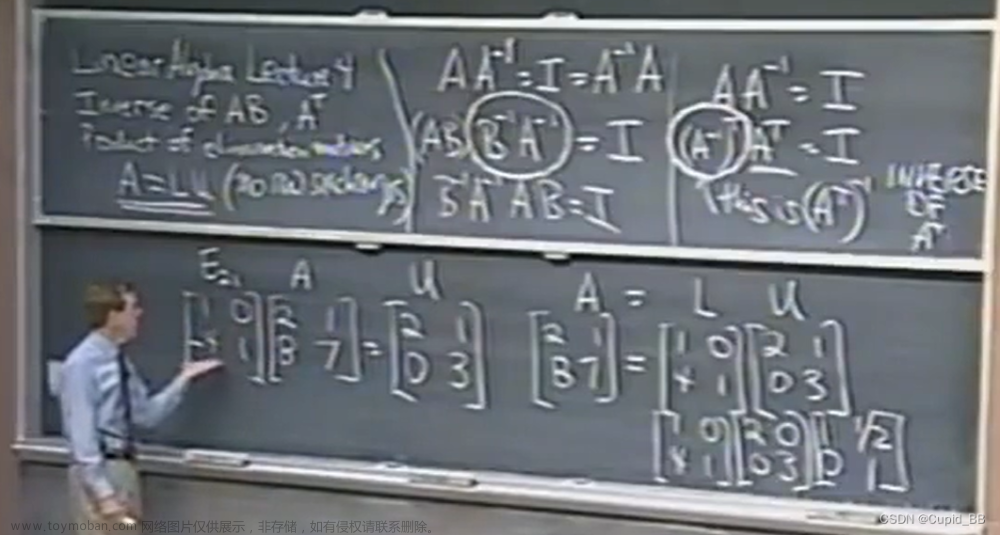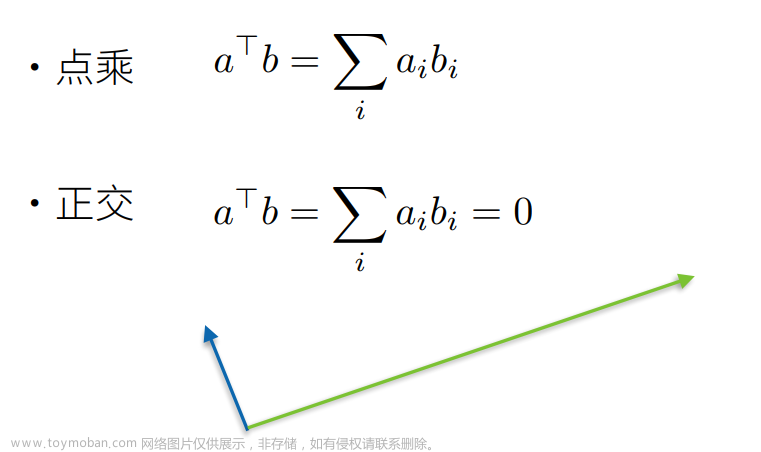咱们网站的这个公式编辑器,估计是后台生成图片后贴回来的,固定分辨率而且分辨率不高。
还不如先离线 latex 生成 pdf 后再截图上来
1. Why QR
When A and b are known, to solver the minimization of , where .
The reduction of A to various canonical form via orthogonal transformations should use Householder reflections and Givens rotations.
2. preview on orthogonal matrix
2.1 Orthogonal matrix
is orthogonal matrix, if:
2.2 rotation matrix is orthogonal matrix
If
is orthogonal and is a rotation matrix.
If , then is obtained by rotating counterclockwise through an angle .
2.3 reflection matrix is orthogonal matrix
is orthogonal and is a reflection matrix.
If , then is obtained by reflecting the vector across the line defined by
That means and are axial symmetry by S,
x is the preimage, y is the image, S is the mirror surface.
looks like :

%input x, ta = theta
%x = [-sqrt(2)/2.0, sqrt(2)/2.0]
x = [1; 1;]
ta = pi/5
S = [cos(ta/2.0), sin(ta/2.0)]
Q = [cos(ta), sin(ta); sin(ta), -cos(ta);]
y = Q*x
figure;
%1. draw axis
xmin = -2
xmax = 2
ymin = -2
ymax = 2
axisx = xmin:xmax;
axisy = zeros(size(axisx));
plot(axisx, axisy, 'k--', 'LineWidth', 0.7); % Plot x=0 axis
hold on;
plot(axisy, xmin:xmax, 'k--', 'LineWidth', 0.7); % Plot y=0 axis
hold on;
%2. draw surface of mirror
sx = -2*S(1):0.5:2*S(1)
sy = (S(2)/S(1))*sx
plot(sx, sy)
text(sx,sy, 'S')
hold on;
%3. draw preimage
plot(x(1), x(2), 'ro')
text(x(1)+0.1, x(2)+0.1, 'x')
hold on;
%4. draw image
plot(y(1), y(2), 'bo')
text(y(1)+0.1, y(2)+0.1, 'y')
%5. axis label
xlabel("X")
ylabel('Y')
v=[xmin, xmax, ymin, ymax]
axis(v)
%axis on
3. Householder transformation
3.1 Householder matrix
In section 2, the reflection is introduced from the mirror surface. But, in this section, it is introduced from normal direction.
Let
then is
a
or
or
which are synonyms.
And is the .
When
is the image from by reflecting with the hyuperplane and the mirror surface is cross the point.
If
let (this is the normal direction)
then ;
约化定理:
Let ,
then st.
and:
(1)
约化定理毕;
约化定理example:
Let then , and
to calculate :
then
Here is the matlab code:
reduce_01.m:
x=[3;5;1;1;]
sigmaa =sign(x(1))*norm(x)
u = x+sigmaa*eye(4)(:,1)
betaa = 0.5*(norm(u))^2
H = eye(4) - (1.0/betaa)*u*u'
%debug
%h=betaa*H
y = H*x

3.2 QR decompose
Theorems 3:
and then is orthogonal matrix, st. , and is a upper triangular matrix.
Theorems 4:
and then and , is orthogonal matrix, and is a upper triangular matrix, st. .
and if , then the decomposition is unique.
Let‘s more concrete, do an example:
Ex3,
decompose , with
PF:
1-st column:
By formulas (1), calculate st.
matlab codes:
A=[
2,-2, 3;
1, 1, 1;
1, 3,-1;
]
x=A(:,1)
sigma=sign(x(1))*sqrt(x'*x)
miu=x+sigma*eye(3)(:,1)
beta=sigma*(sigma + x(1))
H=eye(3) -(1.0/beta)*miu*miu'
H*A
2nd-column:
find , st.
with the formulas again:
now
文章来源:https://www.toymoban.com/news/detail-824342.html
for ,let
and
so
matlab codes:
A=[
2,-2, 3;
1, 1, 1;
1, 3,-1;
]
x=A(:,1)
sigma=sign(x(1))*sqrt(x'*x)
miu=x+sigma*eye(3)(:,1)
beta=sigma*(sigma + x(1))
H1=eye(3) -(1.0/beta)*miu*miu'
A1=H1*A
x = A1(2:3,2)
sigma = sign(x(1))*sqrt(x'*x)
miu = x+sigma*eye(2)(:,1)
beta=sigma*(sigma+x(1))
H2_=eye(2) - (1.0/beta)*miu*miu'
H2=zeros(3,3)
H2(2:3,2:3)=H2_
H2(1,1) = 1
A2 = H2*A1
R=-eye(3)*A2
Q=(-eye(3)*H2*H1)'
未完待续 ... ...文章来源地址https://www.toymoban.com/news/detail-824342.html
到了这里,关于理顺 QR 分解算法的文章就介绍完了。如果您还想了解更多内容,请在右上角搜索TOY模板网以前的文章或继续浏览下面的相关文章,希望大家以后多多支持TOY模板网!











